Heroes and Humanity: Jack Kirby at the Skirball Center
Last Friday, as an early Father’s Day gift, my wife arranged for us to spend the afternoon at the Skirball Cultural Center in Los Angeles, which is hosting a wonderful new exhibition dedicated to the memory and achievement of a great American artist. Titled Jack Kirby: Heroes and Humanity and running until March 1, 2026, the show is a must-see for any admirer of the King of Comics.
Jack Kirby is arguably the most influential person in the history of mainstream American comic books; his work, more than that of any other artist or writer, defined the visual grammar of the superhero. Along with his partner Joe Simon, he created Captain America in the 1940’s, soldiered through the postwar superhero slump of the 1950’s doing work in all genres — science fiction, war, horror, western, and romance (it’s an often forgotten fact that Simon and two-fisted Jack Kirby created the romance comic book) until, in the 1960’s, when DC showed that there was a reawakening market for costumed heroes, he teamed up with Stan Lee to create the “Marvel Universe”, though they didn’t know that’s what they were doing when they did it.
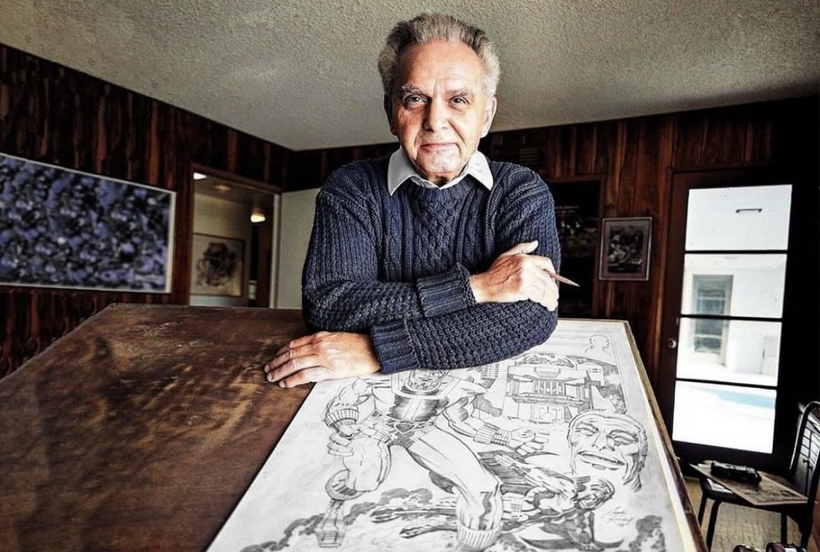
The 60’s saw a flood of characters from Kirby’s pen, most created in collaboration with Lee — the Fantastic Four, Galactus, the X-Men, Thor, Loki, the Black Panther, Ant-Man and the Wasp, the Inhumans, Ka-Zar, MODOK, the Hulk, the Avengers, Iron Man, Doctor Doom, Nick Fury and countless others were the products of his seemingly inexhaustible imagination.

Then, in the 70’s at DC, now working without collaborators, Kirby inaugurated his toweringly ambitious, interlinked “Fourth World” series of comics, with characters such as the New Gods, the Forever People, Mister Miracle and Darkseid, in addition to enduringly popular stand-alone characters like Omac, the Demon, and Kamandi.
Perhaps the greatest indicator of Kirby’s quality is that he took Superman’s Pal Jimmy Olsen and made it a wild, hip, must-read book; any man who could do that was something special.
Certainly, there have been few American lives of more cultural consequence, and the fact that the mandarins in charge of prestigious museums and artistic institutions are paying attention to people like Jolly Jack is a welcome change from the days when comic book artists rated a little bit lower than the guys who clean out septic tanks. All credit to the Skirball for giving Kirby a place to shine.
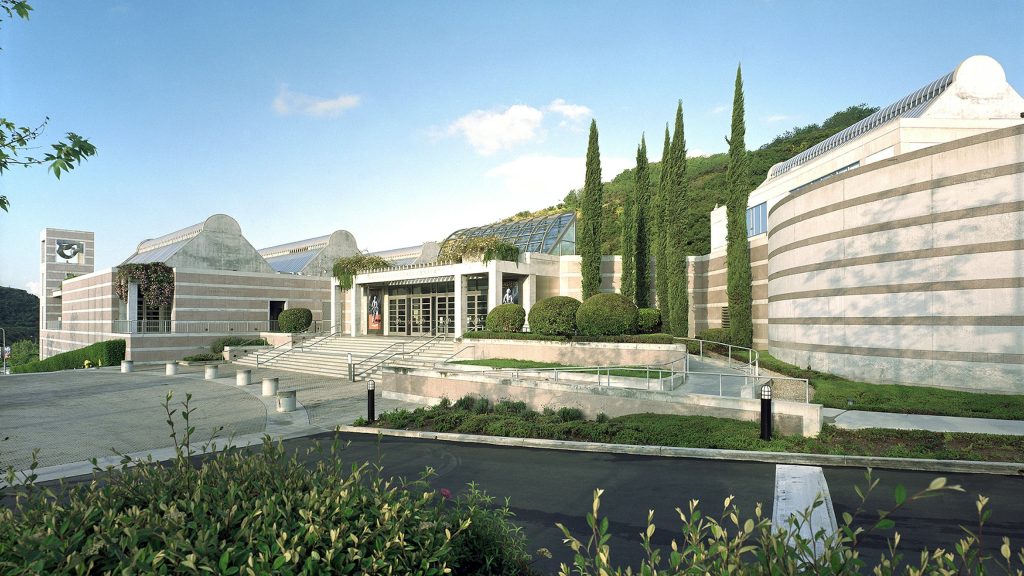
Founded in 1996 and located in the Santa Monica Hills of West Los Angeles, the Skirball Cultural Center is dedicated to celebrating the Jewish experience (especially the American Jewish experience), which makes it an ideal place for commemorating the legacy of Jack Kirby, who was born Jacob Kurtzberg in Manhattan’s Lower East Side in 1917. Heroes and Humanity is a first-rate tribute to his life and work.
The exhibit is laid out roughly chronologically; the first thing you see as you enter is a wall-sized reproduction of a Kirby drawing of one of the teeming New York City streets of his boyhood. What follows as you snake your way through to the end is virtually a history of the first five decades of American comic books.
After you turn the corner, at the very first stop (“Kirby Goes to War”), you find yourself face-to-face with one of the most iconic images in all of comic art — the cover of Captain America Comics number one, with Cap giving Adolf Hitler a crack on the jaw, all at the behest of Jack Kirby and Joe Simon, two young Jewish-Americans whose country wasn’t even at war with Germany at the time. One look at this cover leaves no doubt that truth, justice, and the American way (to borrow a phrase from another great hero of the day) were antithetical to Nazism and everything that it stood for, even if the government in Washington hadn’t quite gotten there yet.

After a reminder that Kirby didn’t confine his opposition to fascism to the four-color page (a prominent place is made for the Army uniform that he wore while serving in Europe during World War Two), the displays take us through the kaleidoscope of genres that Kirby worked in during the postwar years. There are plenty of actual issues of comic books featured, of course, but most of the Skirball exhibit consists of original Kirby art, both published and unpublished.

It’s a joy to be able to see this work (much of which has never been shown in public before) close up. Most are inked pages, completed by people familiar to comics fanatics — Joe Sinnott, Mike Royer, Vince Colletta, Bill Everett, Marie Severin, Dick Ayers, Chic Stone — but there are also many uninked drawings, allowing viewers to study Kirby’s legendary pencil technique.
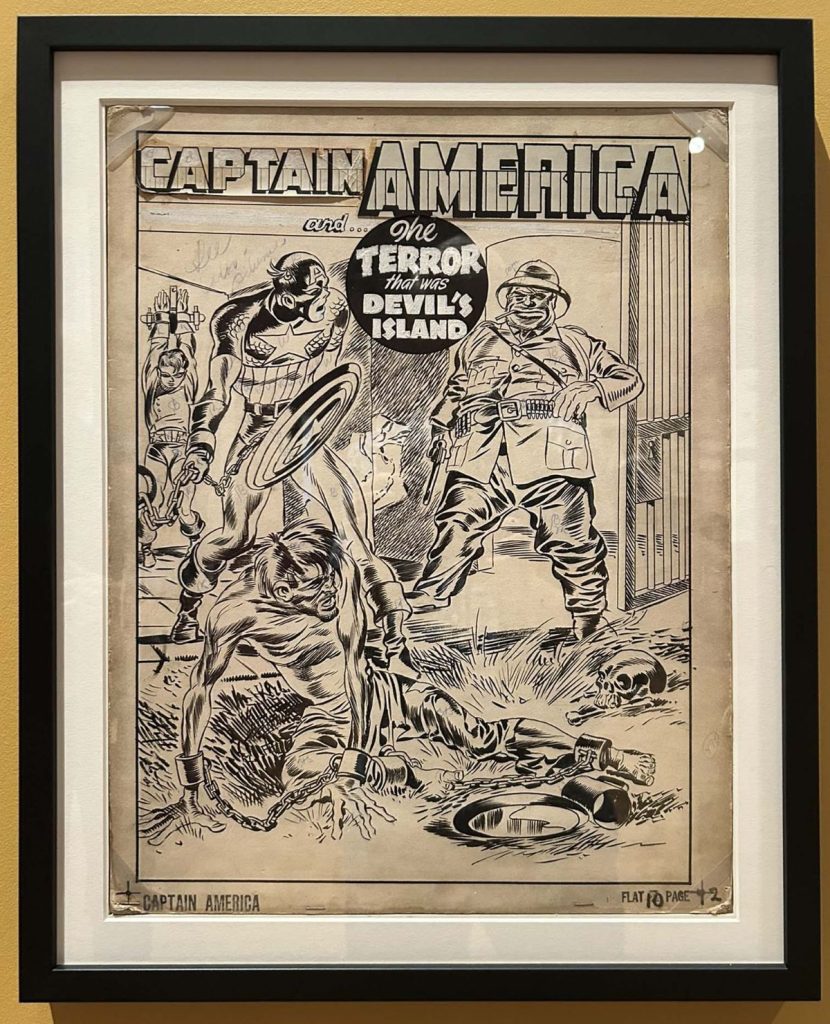
It’s especially nice to see so much of the 40’s and 50’s multi-genre work that Kirby did with Joe Simon, which isn’t as familiar to most people as the King’s later superhero creations for Marvel and DC. I particularly liked a gorgeous splash page, bursting with character and humor, from the western Boy’s Ranch, a title Kirby always cited as one of his favorites.
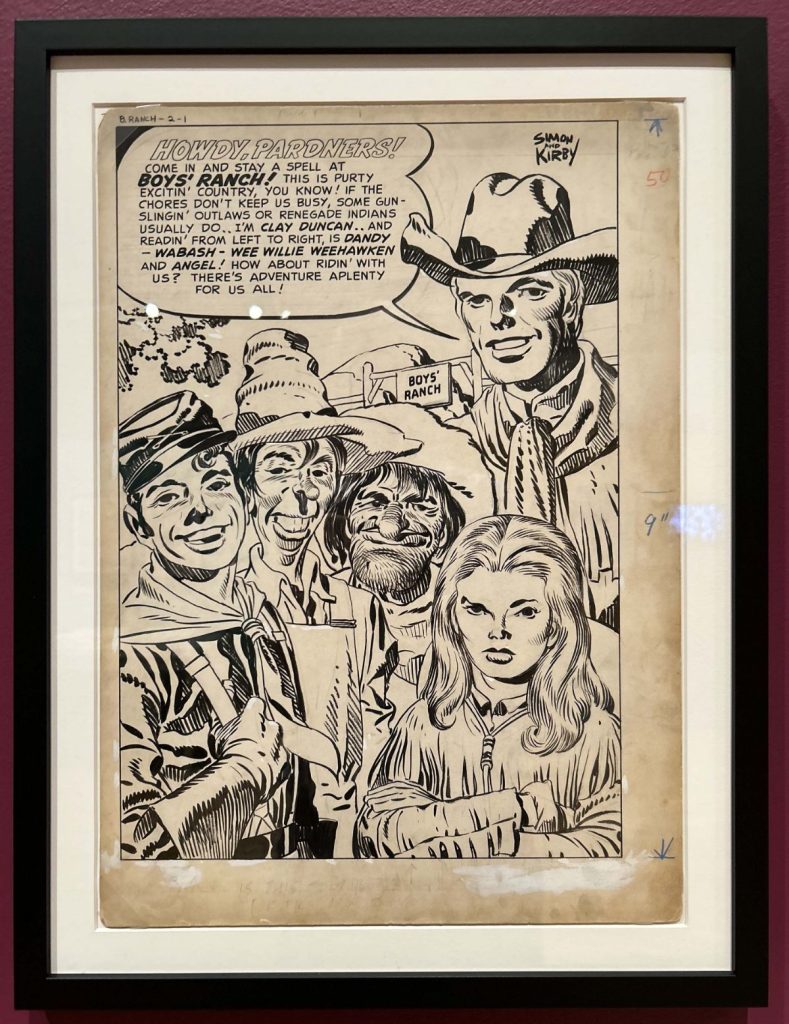
One section of the exhibit is titled “Kirby’s Stylistic Evolution”, and it traces just that, showing how Jack’s layouts and depiction of character and anatomy developed over time, resulting in bold, polished 60’s and 70’s art that was very different from his vigorous but coarser 40’s and 50’s output, while still remaining recognizably the work of the same man. (Once at the San Diego Comic Con, I heard Neal Adams talk about Kirby. “I didn’t like him”, Adams said. “His people were ugly, and they had big teeth.” Never fear — Adams eventually came around to full-blown Kirby worship.)
Of course, the great years of the Marvel 60’s and the DC 70’s form the core of the exhibit, and there is enough of that work at the Skirball to satisfy the appetite of any member of the MMMS or FOOM (that’s the Merry Marvel Marching Society and the Friends of Ol’ Marvel, if you didn’t know, and if you didn’t know, why didn’t you?)
One huge wall (“Re-Inventing the Superhero”) displays an entire X-Men story, and allows you to compare Kirby’s original art with the finished, colored comic book pages that were snapped up off the newsstands by eager kids in the 60’s, long before the Marvel Cinematic Universe was even a gleam in Stan Lee’s eye. (Stan is treated rather gingerly here — the most noticeable thing is that the standard formulation “Stan and Jack” is changed to “Kirby and Lee”, which in this context is only fair — it’s Jack’s show.)
Kirby’s Fourth World art and his other DC characters of the 70’s receive a large share of space, too. I think my single favorite thing in the whole exhibit was a magnificent pencil drawing of the cosmic fascist Darkseid (a character Kirby based on Mussolini), proud, immovable, lost in his dreams of universal dominion. A villain to be sure, but in Kirby’s hands, not just a villain. (I always think of Darkseid’s surprising summing up of the wedding of Mister Miracle and Big Barda: “It had deep sentiment — yet little joy. But — life at best is bittersweet!”)
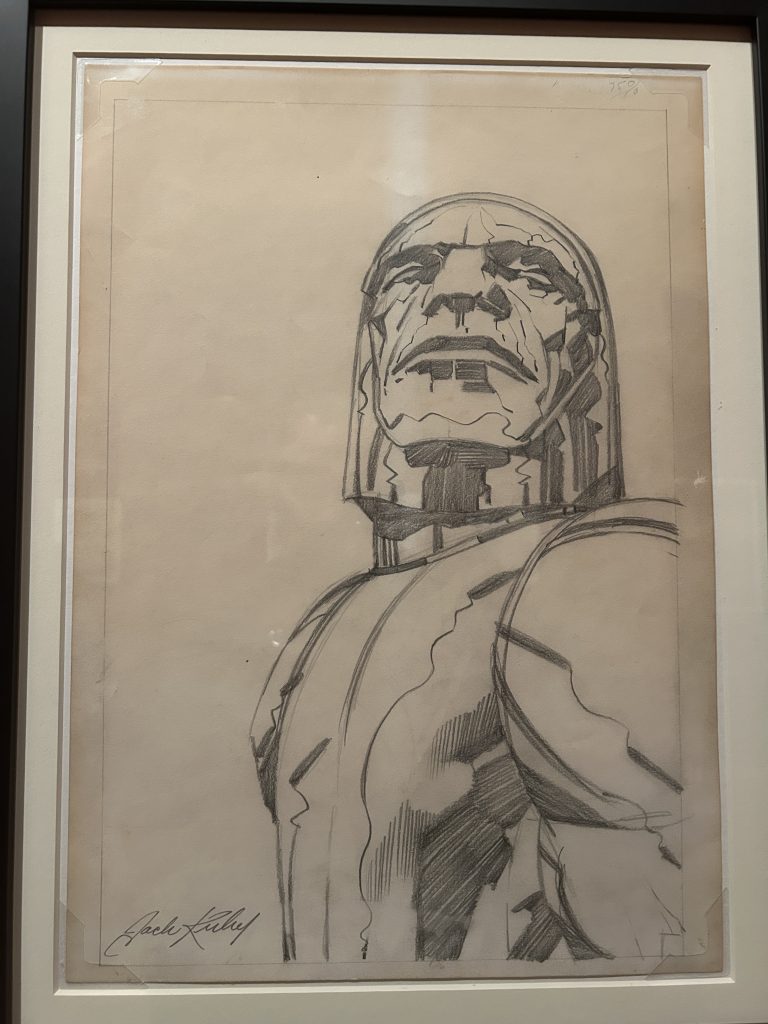
There are several striking examples of Kirby’s non-commercial art, work that he did just for himself or for friends. One of the most eye-catching is his dramatic depiction of the story of Jacob wrestling the Angel from the biblical book of Genesis, and there are several stunning Kirby collages, a form that he seemed especially fond of and that he sometimes integrated into his comic book work. One of the most touching of the personal items is a Hanukkah card that Jack and his wife Roz sent to friends; seeing a yarmulke on the Thing leaves no doubt about what Ben Grimm’s old neighborhood was like. Take that, Yancy Streeters!
There are more treasures at the Skirball than I have room to share with you here; all I can do is urge you to come and see it all for yourself. If you’re in the Los Angeles area any time in the next eight months, be certain to make time for Jack Kirby: Heroes and Humanity. It’ll be time well spent, because Jack Kirby is a man worth getting to know, and he continues to awe, delight, and even teach us.

At another one of those long-ago San Diego Comic Cons, at the annual Jack Kirby Tribute Panel (the one event that I made sure I never missed), I heard the great Spider-Man artist John Romita tell a story about the first time he met Jack Kirby.
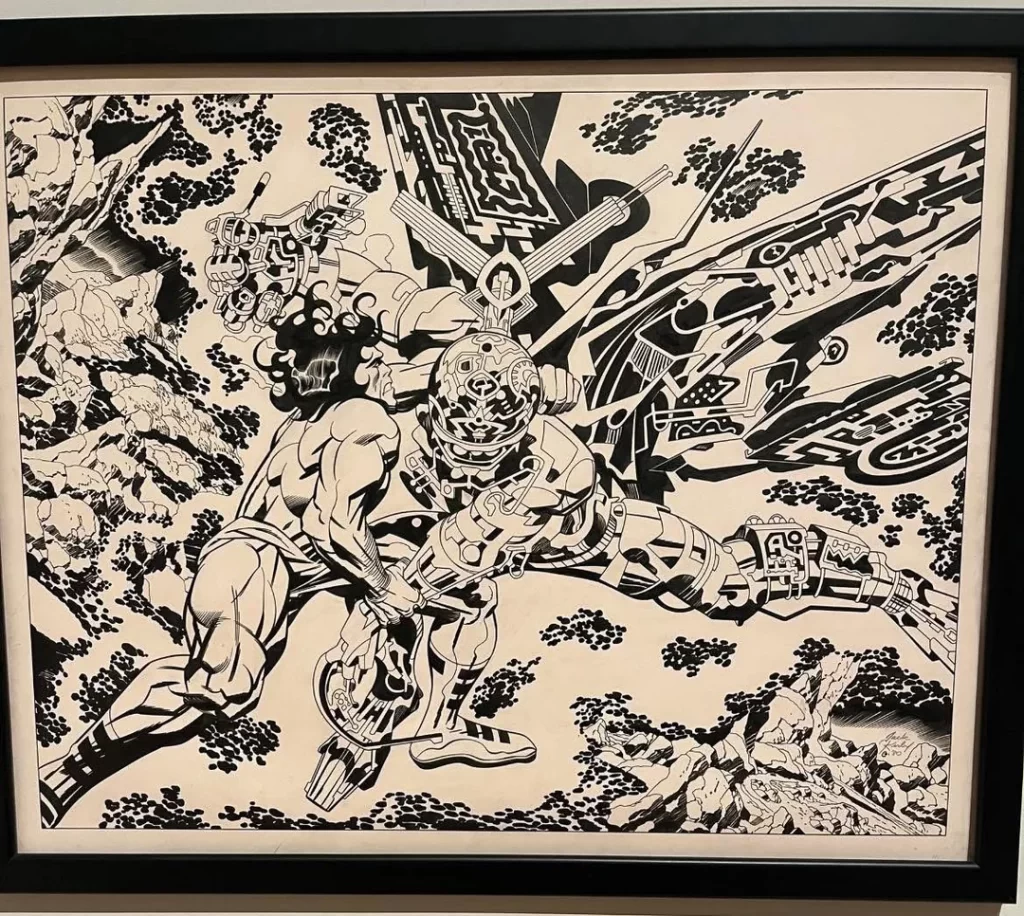
Romita, a young artist just starting out, was in awe of this man who was a living legend. Not knowing what to say to one of his idols, but thinking about Kirby’s brilliant pencil drawings, Romita asked Jack what kind of pencil he used, thinking that the greatest artist in the business would name some fancy imported instrument hand-made out of rare Italian hardwood that cost fifty dollars a box, or something like that.
Jack looked blank for a moment; then he reached into his back pocket and pulled out a plain yellow pencil, the kind you can buy in any drugstore. “A number two”, he said.
He could see from the expression on Romita’s face that this wasn’t the answer the young man was expecting. “Then”, John Romita said, “Jack Kirby said something that changed my life as an artist.”
“John”, he said, “you don’t draw with a pencil.”
Think about that. You don’t draw with a pencil.
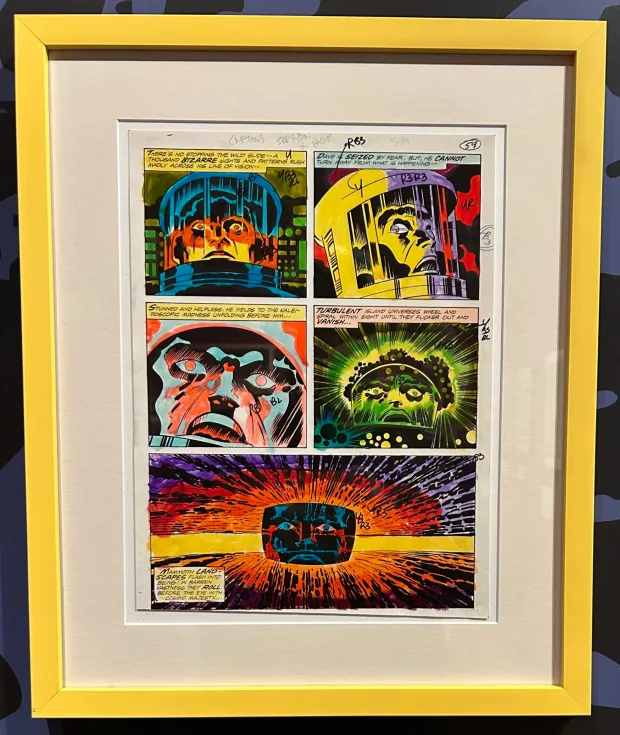
It’s the easiest thing in the world to confuse the tool with the task, but a true artist draws with his mind and his heart, with everything that he is; it’s not graphite or ink or paint that he puts on the page. It’s his soul — that’s why we respond to his work. That’s why it moves us, frightens us, excites us, exalts us, why it grabs hold of us and won’t let go; that’s why we love it.
Jack Kirby, who labored in the lowly comic book industry when that meant being disrespected and underpaid, was a true artist, and if he’s finally getting his due, then there’s hope for us all. Find out for yourself; come and pay him a visit.
Thomas Parker is a native Southern Californian and a lifelong science fiction, fantasy, and mystery fan. When not corrupting the next generation as a fourth grade teacher, he collects Roger Corman movies, Silver Age comic books, Ace doubles, and despairing looks from his wife. His last article for us was A Hand-Crafted World: Karel Zeman’s Invention for Destruction

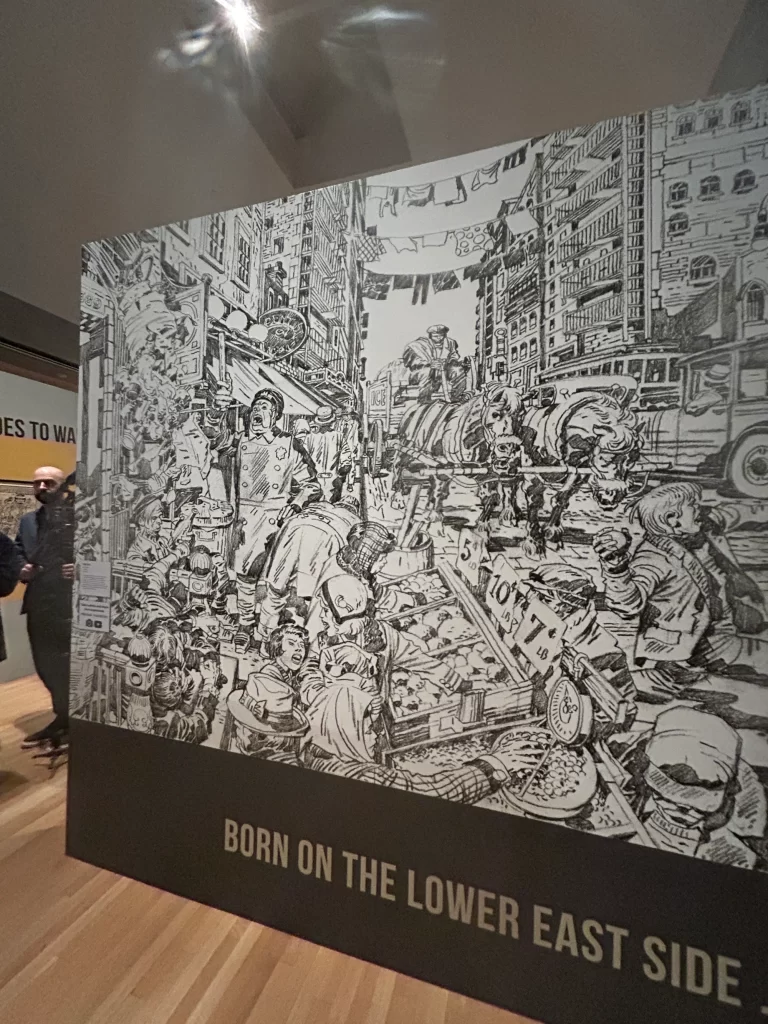
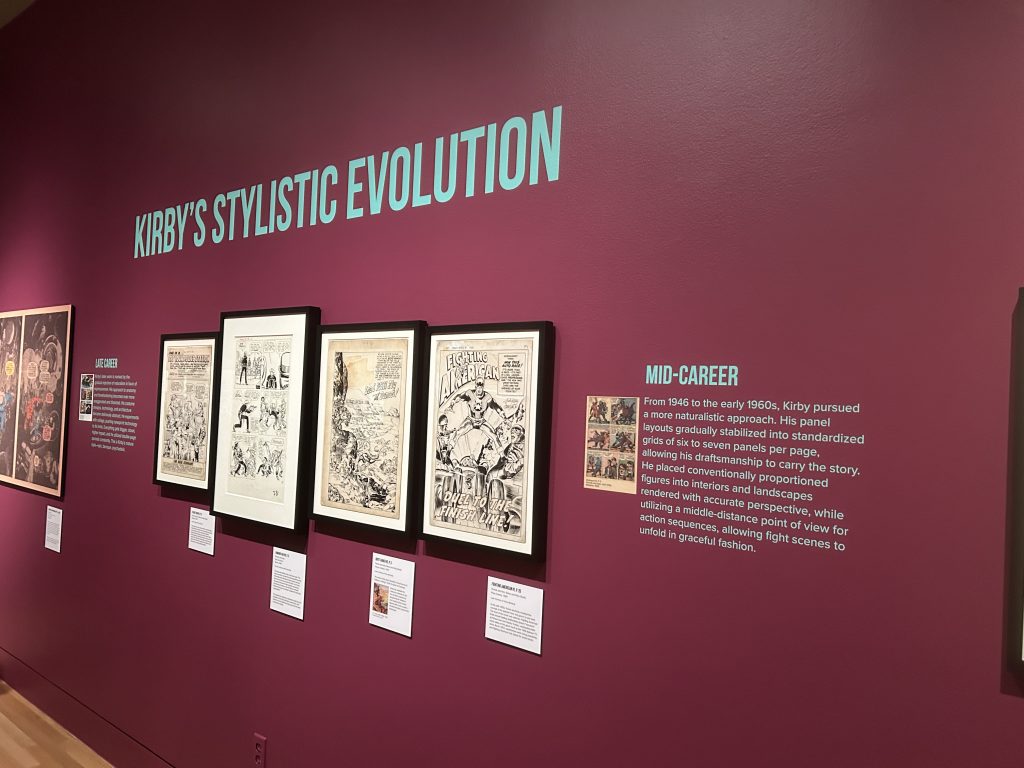

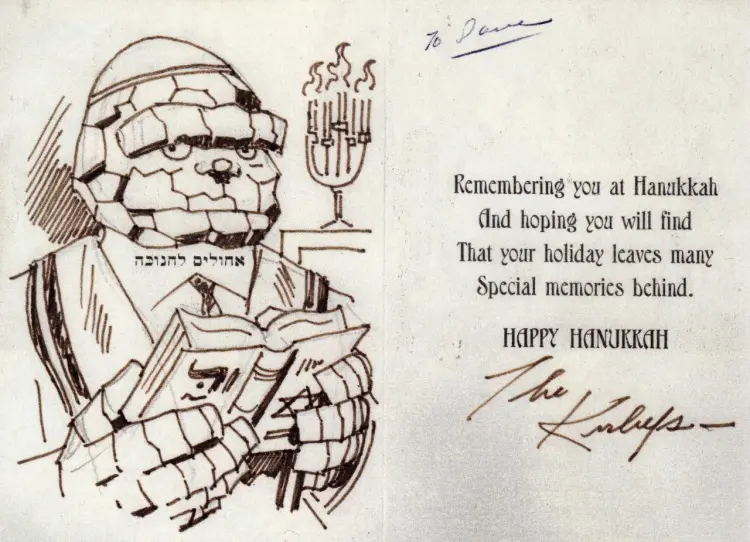
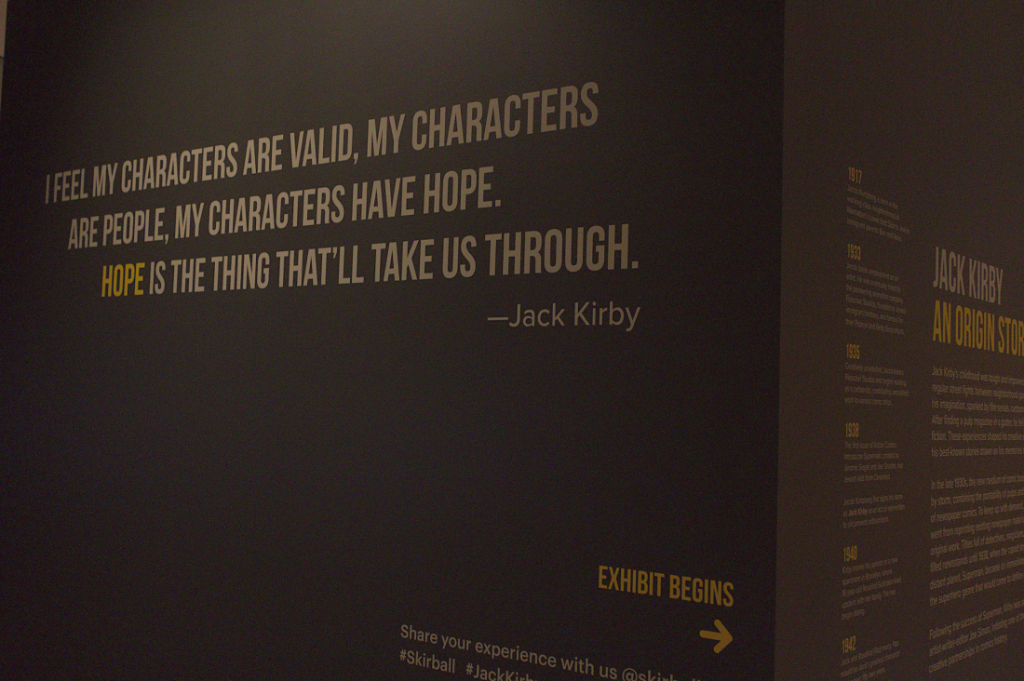
Wow. Kirby was my absolute favorite artist in my formative years (1974-84), and I still consider him to be perhaps the most influential and essential artist of the 20th Century.
Great piece, Thomas. Thanks for sharing all those awesome photos.
You’re welcome! I have to confess, though, that they’re not my photos. I didn’t even think of doing a piece on our visit until the day after (doh!), and anyway, I don’t have a cellphone and didn’t think to ask my friend Todd to take pictures with his. (He did get a picture of me afterward, sitting in the same Casa Vega seat that Brad Pitt sat in in Once Upon a Time in Hollywood, but that’s another story.)
Fortunately, everyone else who visits the exhibit takes plenty of pictures, and they’re all over the internet.
A minor Kirby creation, but one I found interesting, was Lancelot Strong/The Shield, a briefly published superhero from Archie Adventure. He was a curious hybrid of Kirby’s creation Captain America (secret identity as an army private, flag-themed uniform, powers granted by scientific treatment of an ordinary human being) and Superman (raised by an elderly farm couple after he was orphaned, had a number of similar powers). I didn’t know why he vanished after only two issues but I used to wish there had been the chance to see more of him.
Kirby deserves the title of King, for sure. I would say his work is better appreciated these days on repeat viewings, when you can get a deeper appreciation for his ability to lay out a story and show such dynamism in a static medium. A Kirby book is never flat, it’s always kinetic…but clear.
Also, the Kirby Crackle! Oft-imitated, never surpassed.
I wonder what a Kirby book would look like today? How would Jack feel about the deconstructed storytelling in modern comics? Would he consider it self-indulgent or relish the opportunity to spend more time and add more depth to a story? Would he start inking more of his own work? Would the remarkable Kirby speed continue in this era? (Jack was drawing multiple books a month for years at a time, plus additional covers, etc. Few artists can manage a monthly schedule one 1 book for more than a year these days it seems.)
The things we would have loved to get from Kirby that we never got is a topic in itself. In that regard, I always think of the much-ballyhooed JLA-Avengers crossover of twenty-plus years ago. Now there’s nothing more unfair than faulting an artist because he’s not a different artist.
So here goes…
George Perez is a terrific artist, no doubt, and of course they got him for this series – all those characters to get in, and Perez is an unparalleled panel-packer. I get it. But…
Issue two, Superman and Thor get into it; DC vs. Marvel reduced to its essence. Thor raises his hammer and brings it down on Superman…and Superman stops it with his bare hand. Could anything be more dramatic, could any moment be more iconic? Not if it occupies TWO (SMALL!!) PANELS on a twelve panel page.
If Stan Lee had given Jack Kirby a script that called for a layout like that, Kirby would have walked in Stan’s office and hollered, “Are you crazy?! Have you forgotten everything you ever knew about comics?!”
Kirby would have given us a full page image at least (maybe a two-page centerfold), showing the two heroes in full-figure, so you could see every straining muscle, so you knew that nothing could be more dramatic, more cataclysmic, more consequential than this moment.
Whew! I’ve wanted to rant that rant for twenty-two years. Thanks!